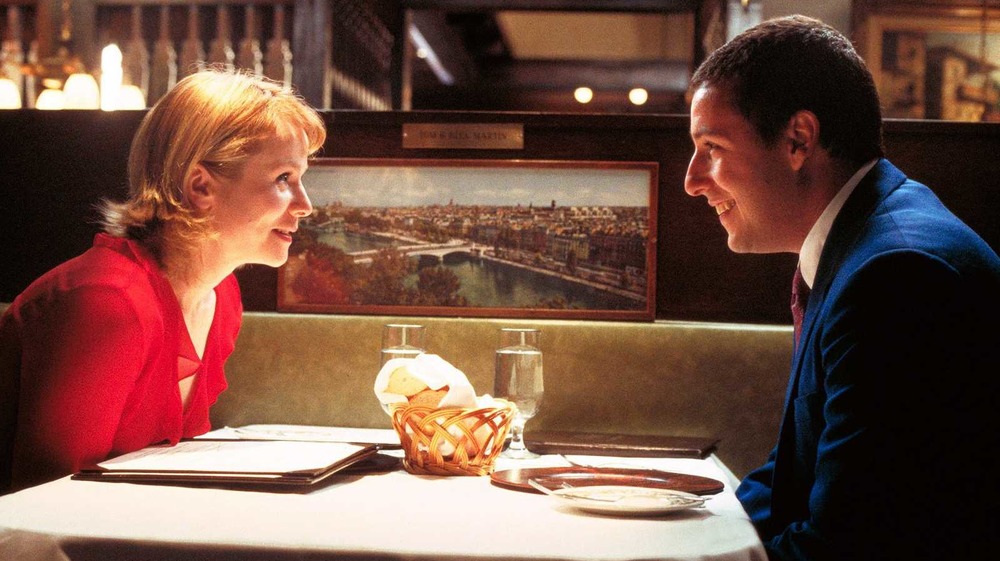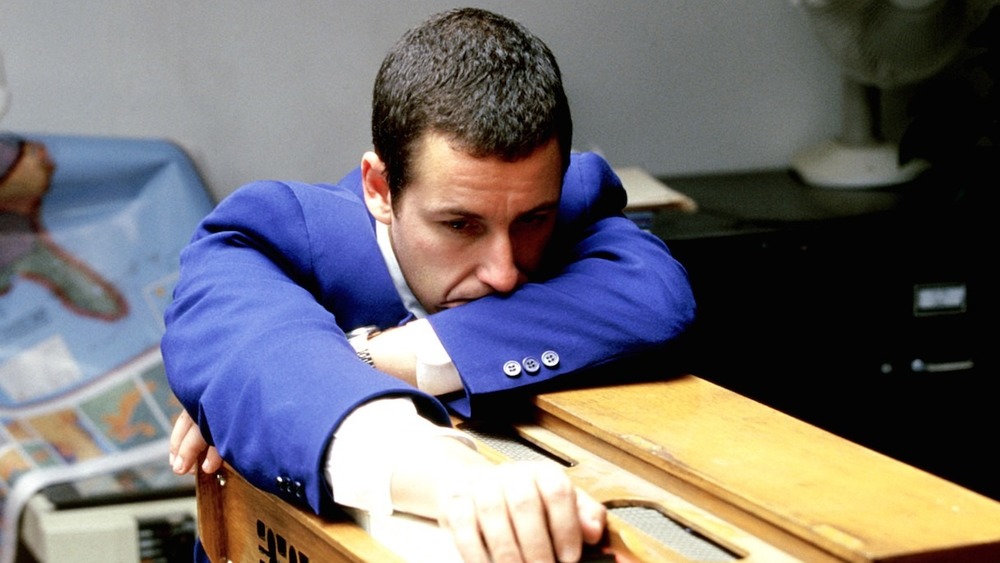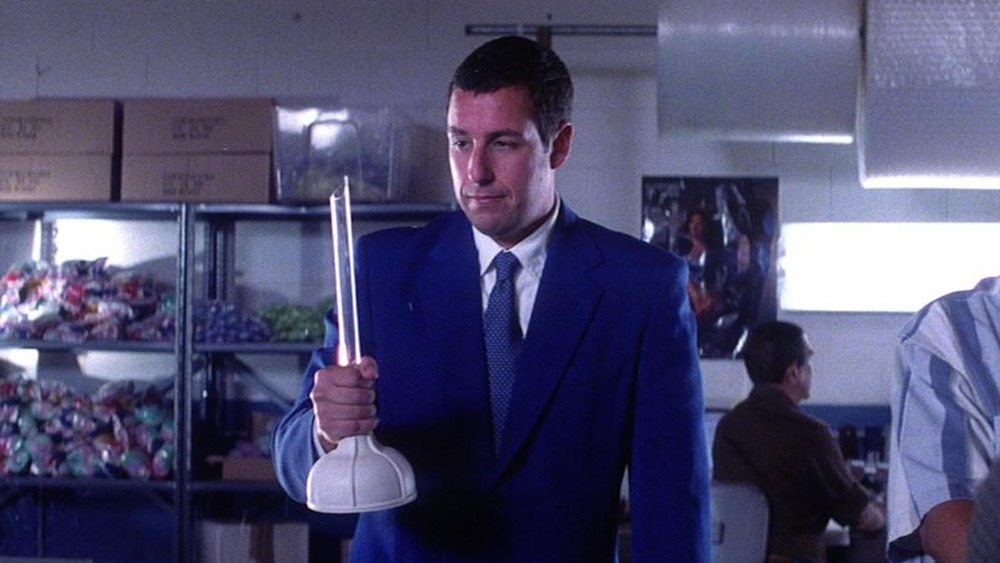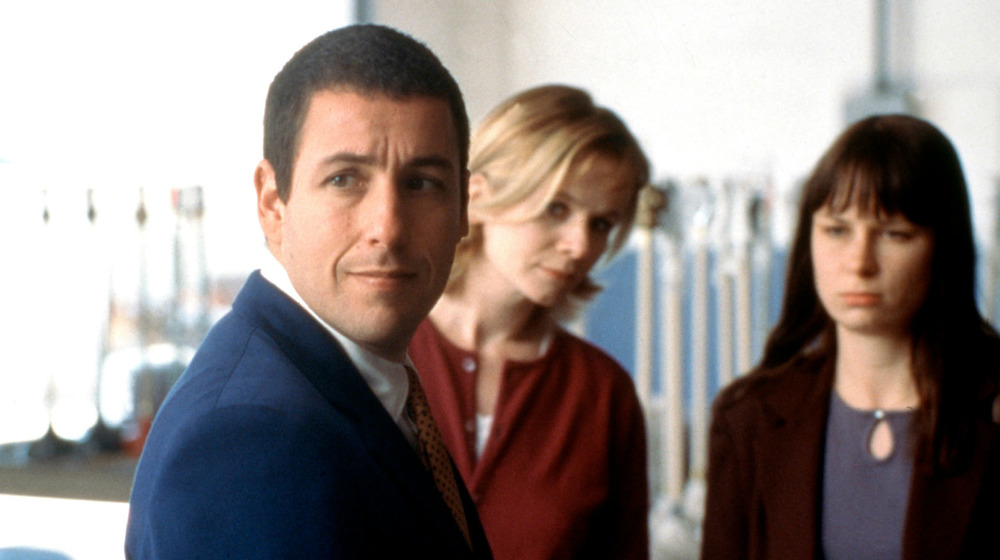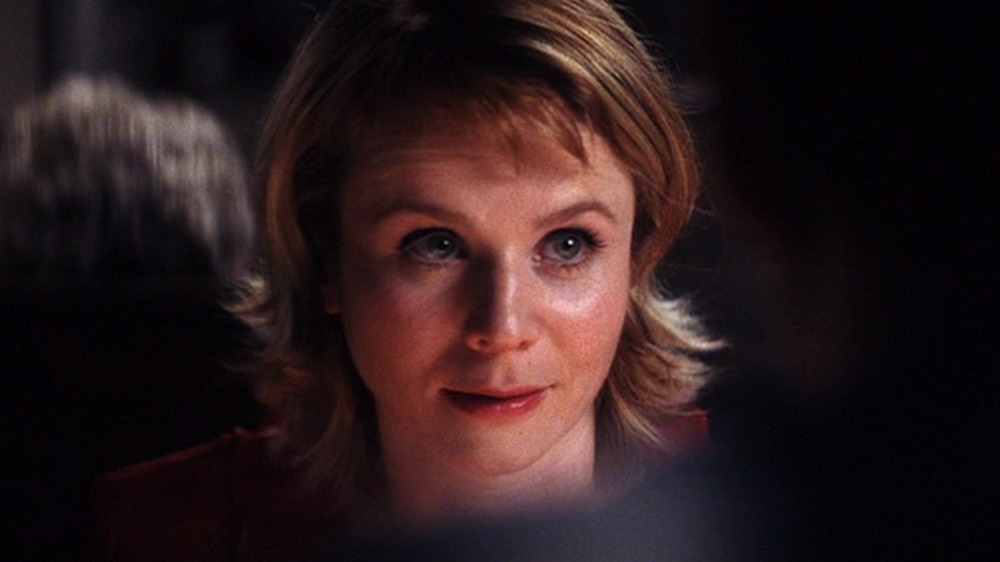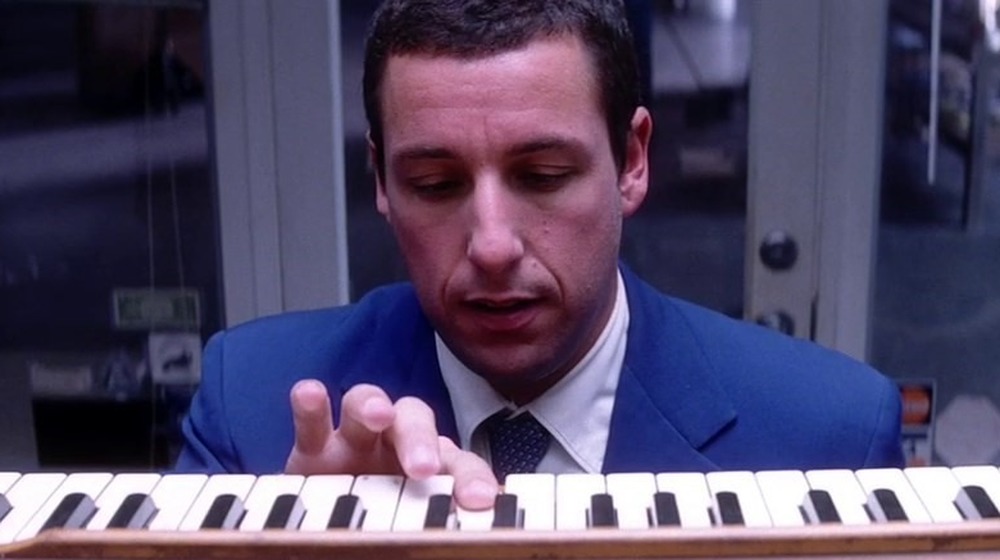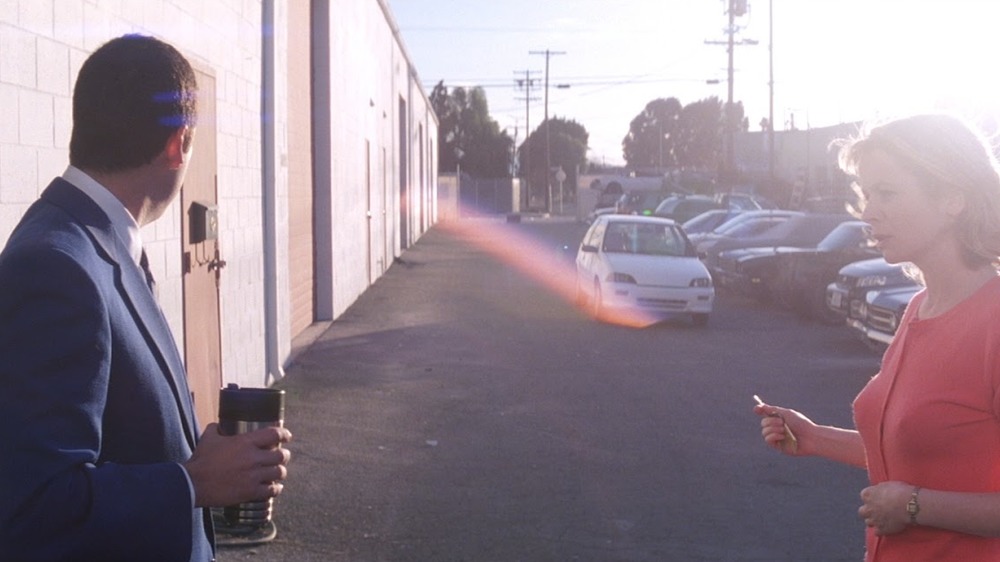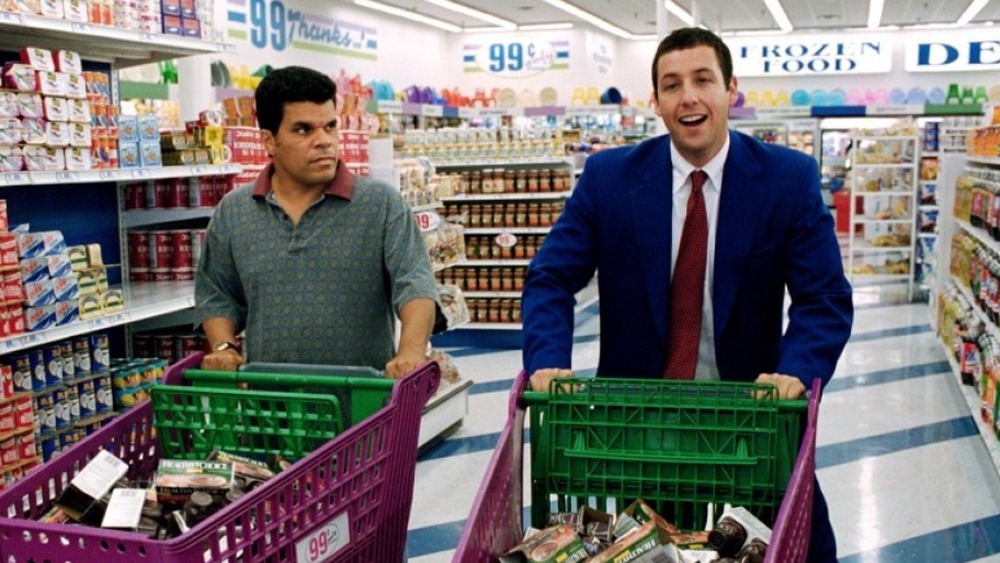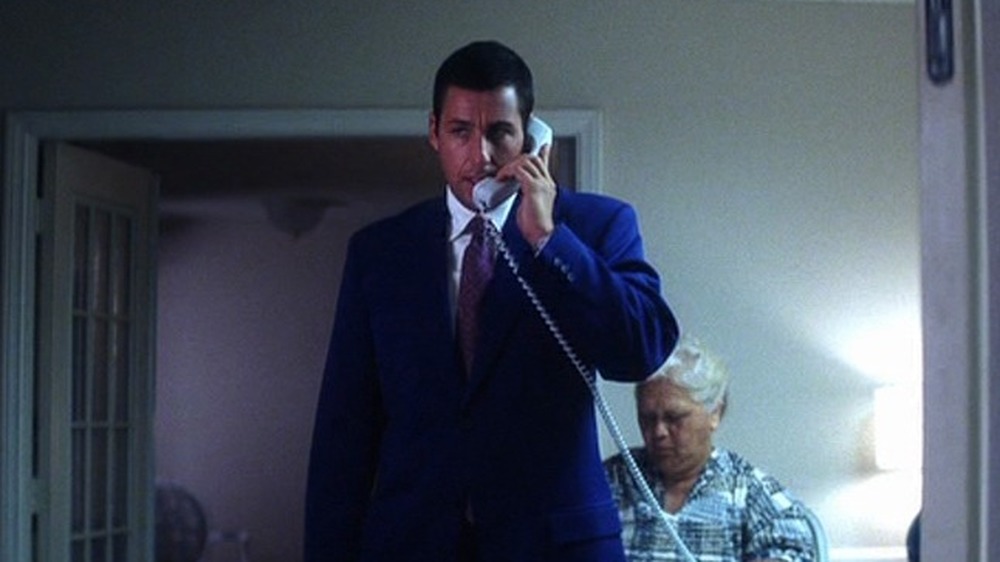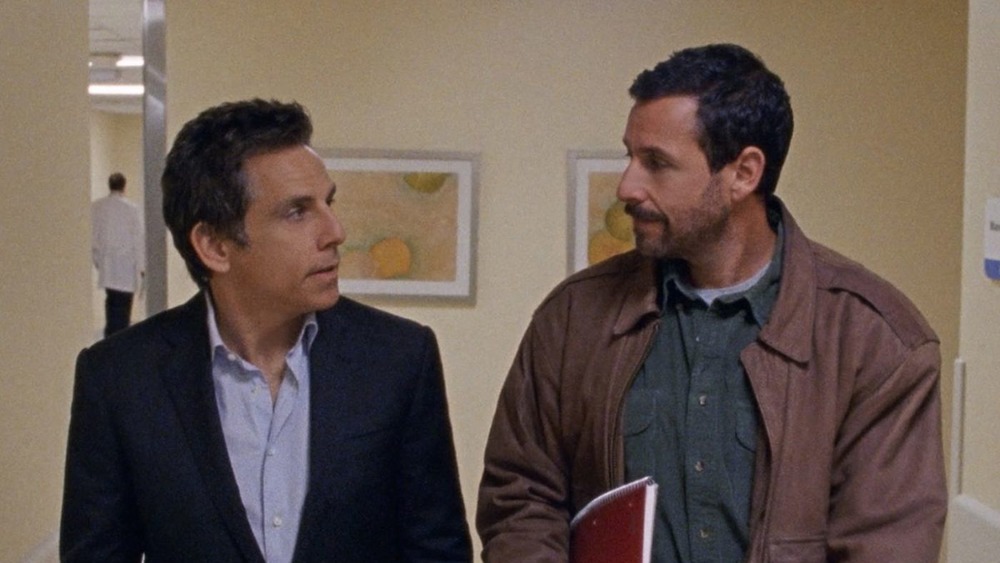Why Punch-Drunk Love Is The Greatest Paul Thomas Anderson Movie Of All Time
You may remember Dirk's prodigious "diggler" or how Daniel Plainview drank your milkshake, along with many other memorable scenes from the mind and films of writer/director Paul Thomas Anderson. You might also recall Punch-Drunk Love (2002), his fourth feature, as "the one with Adam Sandler." But did you know that Punch-Drunk Love is actually Paul Thomas Anderson's best movie? That's a bold statement to make when you put the movie up against Magnolia, The Master, or Phantom Thread, but there are several reasons why this movie stands head and shoulders above the others.
At the heart of the film is a magic trick wherein Anderson doesn't subvert expectations, but plows head-first into them. The right-hand misdirection is so good, many people never realize what's happening in the left hand. Looper.com digs deep into how he did it, and why Punch-Drunk Love is the greatest Paul Thomas Anderson movie of all time.
Paul Thomas Anderson, writer and director
Punch-Drunk Love returned writer-director Paul Thomas Anderson to the more intimate brand of storytelling found in his debut feature Sydney (1996, later titled Hard Eight). After that film, he directed two films with large ensemble casts, Boogie Nights (1997) and Magnolia (1999).
The ensemble casts and rambling story structures often got Anderson pegged as the next Robert Altman, a director famed for just that type of storytelling with films like M*A*S*H, Nashville, and The Player. Anderson could have very easily kept going in that direction, but instead chose to do essentially a two-character story.
Anderson's eye for characters made him a great partner for Sandler. In scenes where the typical "Happy Madison" tropes could have been employed, Anderson eases away. Rather than laughing at a pratfall and moving on, he puts the camera straight on Sandler's face or defensive body language and waits. This pushes the viewer past a cringe-comedy moment to get into the real unease of Sandler's ever-anxious character, Barry. Anderson also gets into Barry's head in scenes where he is alone: he's often viewed in a wide-angle shot in big rooms, with Barry corralled into a corner, making him visually as small as he feels.
Likewise, when Barry begins to open up and feel more confident about himself, the lens opens to the wider world around him — not in an overwhelming way, but making him part of his landscape, versus being apart from or at odds with it.
Adam Sandler before Punch-Drunk Love
Prior to Punch-Drunk Love, an Adam Sandler movie followed a tried-and-true structure:
- A socially awkward manchild is challenged by a love interest that is out of his league.
- His character has a task he must complete to prove he is worthy of love.
- The character's main issue is not so much about growing up but owning the adulthood he already inhabits.
- A "pop song" underscores a character's transition.
- In the end, the guy gets the girl — he's not 100% changed from before but accepts himself as a work in progress.
Sandler's portrayal of this stock character tended to be much the same from movie to movie, as a loser who has grown comfortable with his lot in life. There is nothing to challenge his lack of motivation or his emotional stasis, so he sticks to what works for him, and only that. He seems to be okay with it, but this is a front to cover disappointment and internalized anger. Once the great challenge presents itself to him, he realizes that changes are necessary, but he's completely inept at them. Eventually he realizes he's not going to "fail up," and must get serious about succeeding. It doesn't mean he miraculously stops being kind of a jerk, but now he recognizes that in himself and seeks to confront it.
It might seem like this has nothing to do with Punch-Drunk Love, but actually it has everything to do with it.
Punch-Drunk Love, the story
Barry Egan (Adam Sandler) is a loser in love and life. He runs a novelty toilet plunger company which is constantly derided, as are all of his choices, by his seven emasculating sisters. They mock his sex life or lack thereof. Craving intimacy, feeling beaten down by his sisters' taunts, Barry goes home and calls a phone-sex line. Ashamed, he attempts to cut off the call before more charges go on his credit card, then just cancels the card.
The next day, one of Barry's sisters brings her co-worker to his office. Lena (Emily Watson) is attractive, smart, assertive, and more confident than Barry, but she does not challenge him forcefully as much as she entices him carefully. But Barry is his own worst enemy. He has to deny his worst instincts and give himself the permission to attempt to love someone else, regardless of the fear of failure or embarrassment.
He also has to stand up to Dean (Phillip Seymour Hoffman), a mattress salesman who runs the phone-sex scam on the side. Dean wants the money that he thinks Barry owes him. He makes threatening calls to Barry, sends goons to intimidate him, and eventually brings violence upon Barry and Lena to extract the money.
Barry finds his courage and fights off their attackers, but he can either stay with Lena at the hospital after the attack knowing Dean won't stop, or he can leave to face Dean head-on, hoping that Lena will understand.
The secret: it's actually like every Sandler movie
When one compares the Adam Sandler movie structure to Barry Egan, the character tics all match: a loser in life and love, pent-up aggression toward a world that seems to exist only to undermine him, a bizarre obstacle that he must overcome to prove he is indeed worthy of good things, and an ending that suggests he's still a loser, but on the right side of working it out.
Plot twists, like a phone-sex encounter that goes horribly wrong, read on paper like prime fodder for Sandler's broad but cringe-y comedy. Barry's plan to exploit a loophole in a health-conscious food brand's promotion, and amass a million frequent flyer miles by purchasing large quantities of pudding, would ordinarily read like a wacky hare-brained scheme. So how did this become a Sandler movie made by Anderson instead of an Anderson movie that happened to have Sandler in it?
The key is perspective. In the standard model, Sandler's movies are objective. You view characters like Happy Gilmore or Billy Madison from a safe distance, so when they are hurt, it's for comic effect. Punch-Drunk Love is designed to be subjective. Long moments of silence and small actions reveal character and help the viewer get into Barry Egan's head. Pratfalls aren't accompanied by madcap music and are, instead, usually scored with the sounds of an encroaching, dangerous world. When Barry gets hurt, the viewer is not inclined to laugh at the display of pain.
Emily Watson, a worthy sparring partner
Emily Watson portrays Lena, a co-worker of one of Barry's sisters. She is successful and far more confident than the ever-anxious Barry. She embodies the potential for love and romance, as seen in her introduction in Barry's novelty plunger shop in an industrial garage. She wears warm purple colors offsetting the cold, dreary blues that identify Barry's clothes and surroundings. Her posture is straight while his is slumped and defeated. There is something unattainable about Lena.
Lena represents one of the clearest subversions of the Adam Sandler formula in that, even though she's out of Barry's league, she is at least in the same reality.
Typically, the Sandler character falls head-over-heels for the bombshell who has little to no respect for him. Salma Hayek, Jennifer Aniston, Brooklyn Decker, Bridgette Wilson and more are equally unattainable and represent a certain level of wish-fulfillment on the part of the protagonist (and, by extension, the producers and directors). Watson, as Lena, is attractive but in a way that compliments, not contradicts, Sandler. When together, they look like a good couple, not a "movie couple."
More importantly, Watson has the acting chops to elevate Sandler, not limit him, inviting him to step up the same way Lena does with Barry. She says as much with her eyes, smile, and body language as she does with the dialogue. For Sandler, who got far with stunts and goofy voices, it becomes a dance. Can he keep up?
The music of Punch-Drunk Love
The score for Punch-Drunk Love was written by frequent Anderson collaborator Jon Brion, a singer-songwriter and music producer who came to public attention through his work with the power-pop band Jellyfish and with production on Kanye West's Late Registration album.
In keeping with the theme of getting into Barry's agitated mind, Brion's score is percussive and anxious, a ticking time bomb symbolizing Barry's habits of lapsing into acts of rage and self-loathing.
The percussive motif lessens as the film goes on, giving way to a more lush approach that underscores the budding romance between Barry and Lena. When violence erupts, the percussive elements return as a leitmotif similar to the two-note pattern John Williams employed in Jaws to herald the presence of the killer shark.
Brion treads that fine line between the terse, metronomic pieces and the obviously romantic ones. He also handles the moments where underscore merges with action skillfully. When done right, music informs movement and vice versa. When done poorly, the effect is called "Mickey Mousing," whereby the music becomes more sound effects than anything else, as one might see in a cartoon. This broad approach was common to Sandler films, and by keeping such tendencies in check, the filmmakers both mirror and distort his previous efforts.
The Barry-Lena romance is capped with the Brion-performed ballad "Here We Go," which features the knowing first line, "You gotta hope that there's someone for you, as strange as you are."
The Olive Oyl connection
If "Here We Go" is Barry's theme, Lena's is even more unorthodox. The mid-movie romantic montage between Sandler and Watson is scored with the song "He Needs Me," written by Harry Nilsson for the Robert Altman film Popeye (1980). The choice of the tune might seem odd but it fulfills two important roles in this film.
First, this track sung by the character of Olive Oyl (Shelley Duvall) might read as random and strange on the outside, but it actually reveals character. Now "trapped" in Barry's thoughts, the audience cannot readily intuit what Lena (Emily Watson) is thinking. Viewers can hear her dialogue, but the dialogue is frequently about characters saying what other characters want to hear, not how they actually feel.
Lena has everything she wants, including self-respect. The void inside her is the desire for an intimacy that surpasses that of two individuals bound by attraction. In Barry, she finds someone trying to change for her and because of her, regardless of her success and confidence.
The sequence featuring "He Needs Me" is a breather at the end of act two, setting up several twists, turns, and resolutions that will be jarring to an audience forgetting some important plot points. In a normal Sandler film, these might go nowhere except for a joke. In an Anderson film, no one mentions a wacky premise like an angry phone-sex operator without paying it off. At least the audience gets a momentary respite with "He Needs Me."
The music of redemption
Early in the film, a harmonium, a keyboard which operates with air bellows like an accordion, is dumped near the industrial park where Barry works. He takes it back to his office. A lot of screen time is devoted to this scene, mostly performed in silence, and viewers might wonder what the significance of it is to the overall plot. It's actually an encapsulation of the entire story.
First, it's a metaphor for Barry himself. It's an abandoned instrument left in the trash, but it could sing again if only someone might find it and care enough to use it. Barry believes in redemption, even if in the earliest parts of the movie he finds himself unworthy of it.
Second, it provides a moment where the audience is invited into Barry's head and becomes one with him. We see his near personification of the instrument, providing it the attention he craves for himself. It is from this point on that the viewer gets to share Barry's emotions versus being an omniscient observer getting a laugh from a stranger's miseries.
Getting to that place is crucial to making the movie work. If the audience doesn't come along for the ride with the subjective viewpoint in place, then all the bizarre plot bits will fail to resonate and will just be weird non-sequitur gags in a standard Adam Sandler flick. This moment between Barry and the harmonium makes all the difference between him and the raging Happy Gilmore.
The filming of Punch-Drunk Love
The often dream-like cinematography from Robert Elswit on Punch-Drunk Love delivers on one of Anderson's goals. As described by composer Jon Brion in the documentary on the Criterion Collection edition of the film, Anderson was going for "a movie musical feeling without actual musical numbers."
Elswit and Anderson achieved this in several ways, particularly how Barry (Adam Sandler) is framed in shots. Barry's suit is a slightly more vibrant version of navy blue, reflective of his emotional state. His surroundings often mirror that blue tone, so lighting is employed to accentuate a cold, isolated feeling that causes Barry to shrink into his surroundings rather than pop out from them.
Elswit also frames Sandler in his shots to less than a third of the screen, often in a corner. The lighting scheme trains the majority of the light onto Sandler, and in these early scenes, Barry seems forever under interrogation.
With the arrival of Lena, often dressed in warm colors, the ever-present blue tone starts to break up. In a memorable scene in a grocery store, Barry does a happy little soft-shoe dance in an aisle, and the colors of the products pop with life. As the film progresses, warm tones continue to emerge and dominate. There is added attention paid to Barry's new necktie, a brilliant red that symbolizes his heart has now been changed by Lena's presence. The trick is making the tonal transitions as seamless as possible.
The art of Jeremy Blake
Jeremy Blake (1971-2007) was a digital and graphic artist whose work adds to Punch-Drunk Love's dreamlike tone. As Barry and Lena's love progresses, the visual motifs of blue, pink, and red paint swirl together onscreen in blurred transitions.
Blake was known in the art world for digital projections as well as traditional paint-on-canvas works. In both, he focused on amorphous shapes and vibrant colors. Most people will recognize his work from the multiple variations of covers he made for Beck's 2002 album Sea Change.
The effect compliments Paul Thomas Anderson's goal of creating "a musical without music numbers." These interstitial sequences add exaggerated visual drama the same way a splashy Technicolor dance sequence interrupts a traditional musical — think Gene Kelly in An American In Paris.
The Blake sequences also provide a break from when movie sequences get too real. In sequences where the action is gritty or anxious, Blake's gauzy, kaleidoscopic transitions act as a breather which remind us that this is a fantasy in many ways. Do not worry that the movie has lapsed into hard-drama territory.
This is a familiar tactic in Anderson's films, from the extended "moment of clarity" Dirk Diggler faces in the home of a coked-out drug dealer in Boogie Nights, set to Night Ranger's "Sister Christian," to a full musical segment in Magnolia featuring Aimee Mann's "Wise Up." Anderson plays with both the storytelling and artifice of the movie format. Blake's pieces help him achieve that same end.
A reappraisal of Sandler, the actor
Punch-Drunk Love was the first, most compelling sign that Adam Sandler had more in him than the bombastic goofballs he staked his professional claim with. Sure, that side of him returned in full force after this film — sometimes for better but often for much worse — but every so often, he has dropped a bomb on the critical establishment to remind them what he's capable of.
More recent evidence came in the Noah Baumbach film The Meyerowitz Stories (2017), alongside Dustin Hoffman, Emma Thompson, and Ben Stiller, and Uncut Gems by the Safdie Brothers, a gritty, harrowing story that had reviewers speculating on an Oscar nomination for Sandler. This did not come to pass.
But you don't get to these two movies without Punch-Drunk Love. Credit must go to Paul Thomas Anderson for potentially reining in Sandler. He is, after all, still doing his shtick, kind of. Yet there are no music cues "Mickey Mousing" their way through the visuals trying to indicate a joke. There's no mugging for the camera. Without the movie-making crutches, the anxious tics are rendered as painful, and Sandler allows it to happen.
Upon multiple viewings, one can see the moments where he finally lets go of even the thinnest version of that comfortable facade. It's as if Sandler finally says to the film-going audience, "So you want to watch me dance? Watch this."
